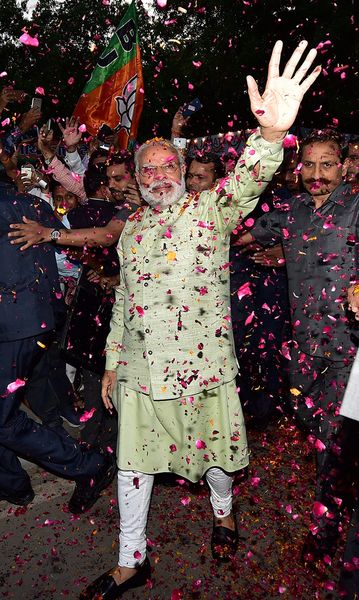 Narendra Modi | PTI
Narendra Modi | PTI
Prime Minister Narendra Modi has owned the national stage for three and a half years. India’s most successful politician of the 21st century did not have a challenger, either from within the party or outside it. Barring the stubborn states on the eastern and western shores, he had smashed the opposition in the Lok Sabha elections. And, apart from a couple of hiccups in two states (Delhi and Bihar), the prime minister was on a one-man charm offensive as he stormed state after state. The most stunning were the victories in Uttar Pradesh, Uttarakhand and Assam, in the first half of 2017. Now, even as he has retained Gujarat and won Himachal Pradesh, taking the NDA kitty to 19 states, the arena has become crowded.
Moditva—a blend of development, political aggression, hindutva, nationalism and a strong personality cult—has been challenged by Rahul Gandhi, the politician whom the BJP most ridiculed.
Even in narrow defeat, Rahul has become the principal challenger to Modi’s brand of politics. It is a challenge which will be repeated in different parts of the country through the next 18 months—the two parties face off in eight states, culminating in the epic battle for the nation’s prime ministership in 2019.
Rahul, as his mother Sonia Gandhi noted, had been strengthened by the personal attacks. He became a new man in the past six months, and his speeches, tweets and actions had shown a hunger to do battle. The old hesitation and confusion had gone. As BJP president Amit Shah carped, Rahul had co-opted outsiders in Gujarat to take on the Modi magic, exploiting the frustrations and grievances. Rural Saurashtra responded.
For 40 minutes on Monday, when votes were being counted in Gujarat, members of both parties were breathing hard. Pulses were racing. Television channels said the Congress “worm” on the electoral graph was crossing and moving above the BJP one. There was an outside chance that saheb, as Modi is popularly called in Gujarat and in his inner circles, was staring at defeat in his home state after an intense and bitter campaign. Then the worms turned, and the saffron one drew level.
By the time Modi drove to Parliament House, he had received reports that the BJP worm had moved up, with the Congress worm tantalisingly close, yet permanently lower. The Sensex, Modi’s biggest cheerleader on the financial front, crashed for those brief minutes and then bounced back.
As the vote percentage showed, Modi is still the favourite son of Gujarat and he has a way of correcting himself, like he did quickly on the disastrous GST rates. He has the power and the conviction to take tough decisions as the government is under his command. Sonia Gandhi had handled rural anger effectively—once in the opposition and once in power. In 2004, she came up with the slogan ‘What Did the Aam Aadmi Get’ to deflate the BJP’s India Shining campaign. Then, when rural angst threatened the UPA in its first term, she bulldozed the National Rural Employment Guarantee Scheme and the farmers loan waiver scheme to retain rural India. Modi, too, has taken note of rural distress and his serious victory speech made him return to the theme of development. But Rahul appeared equally confident that he could prove Modi was “hollow”. While Modi holds many aces, the challenger will keep snapping at his heels. It is a contest worth the Indian democratic spirit.










